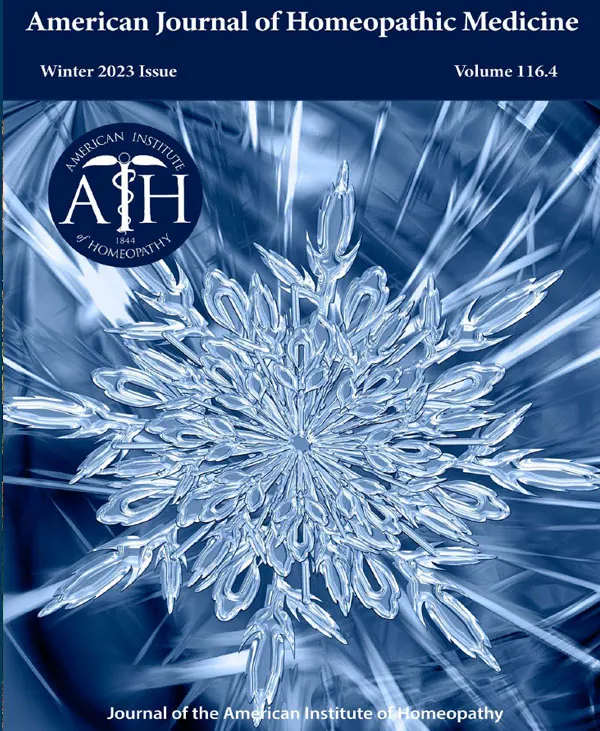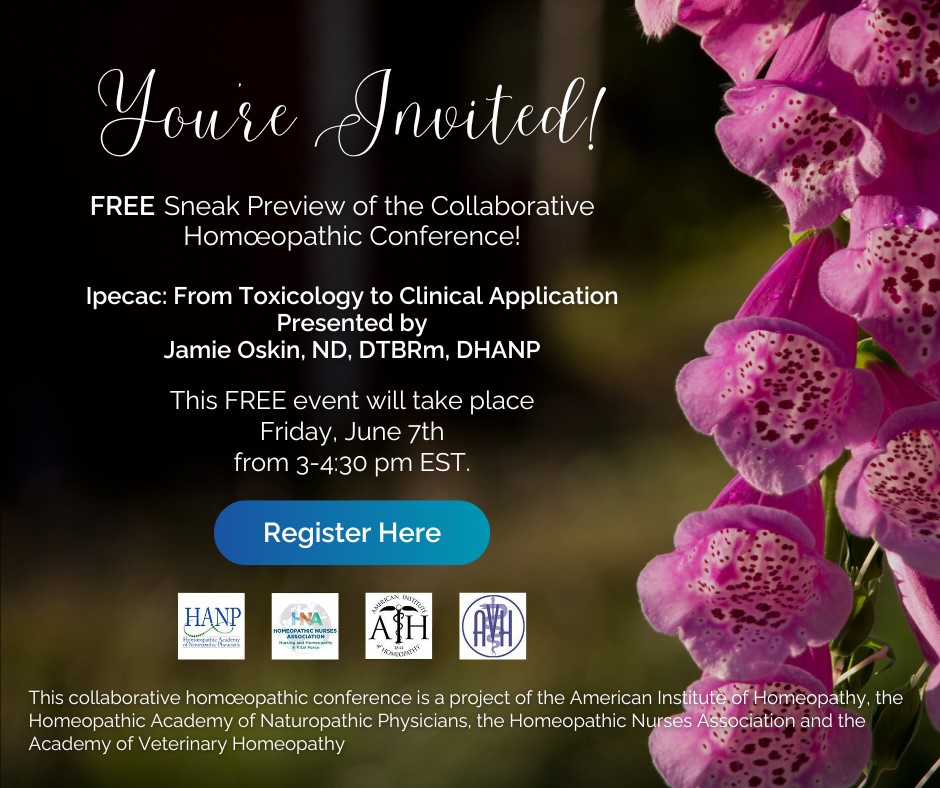
Pathological indications: So-Called
Pathological indications: So-Called
Eli Jones, MD
The following article by Dr. Eli Jones contains a series of cases successfully treated using Veratrum viride in the 1X potency for a variety of conditions, some of which, like congestive heart failure, are difficult to treat with homeopathy alone. There are two aspects of the treatment which migh be controversial—one is the very low potency used and the second is the indication for use. The question of potency can be debated ad nauseam, but it is clear that homeopathy is by definition, first and foremost, the use of medications to treat disease which are similar to the “disease” produced by the medication itself.1 The question of potency or posology is secondary: it may vary according to the practitioner’s understanding of the “sensitivity” of the patient in the state of disease to the agent used to treat. The background of the practitioner is often an influence on the posology used as well. Dr. Jones practiced as an eclectic physician before he was introduced to homeopathy; so he tended to use low potencies. (Of course, quite the opposite is the case with J.T. Kent, who was also an eclectic physician but was known as one of the “high potency men.”)
Often, Dr. Jones’s indications for use were pronounced objective symptoms which were characteristic of the remedy. These symptoms are just as characteristic as any modality or pronounced general symptom of the patient. In fact, one can argue that these symptoms are more reliable from an experienced physician’s point of view. Thus, Dr. Jones, in his article on reading the pulse, eye, and tongue mentions, “Upon reading the pulse, I found it full, quick, irregular, and compressible, which is the pulse of Baptisia. Her tongue had a brown coating down the middle, with dark red edges, which is also an indication for the above remedy; my diagnosis was typhoid pneumonia.”2,3 (See also “Complete Dynamics” for the rubric: Mouth, tongue, brown, center.)
Furthermore, there is a refined diagnostic, management, and prognostic utilization for this approach. In Dr. Jones’s very interesting book on the treatment of cancer, in the section on taking a case he states: “We examine the pulse of our patient; we find the pulse of cancer a weak pulse, often a discouraged feeling to it, and quicker than normal. The weight and feeling of the muscles show lack of nutrition. The tongue, under its yellowish, white color, shows in advanced cancer a dark red color; in the last stages we have the ‘beef steak’ tongue. The white of the eye has a pearly tint with greenish yellow spots, showing a drain upon the system, toxic matter in the blood and decomposition of albumen. The eyes will tell you if the glands are acting normally or not. The tongue shows you whether the patient is digesting his food or not; if he cannot digest his food, he cannot make good blood. The pulse tells you whether the vital forces are strong or weak …”4
Thus, we can say that this approach is as “homeopathic” as any of the traditional Kentian and Boenninghausen approaches.
What Can Be Accomplished with One Remedy5
By Eli G. Jones, MD, Buffalo, N.Y.
Veratrum viride
“ … What the student wants to know is what you know about the remedy by actual clinical experience with the remedy at the bedside of the sick …
I have learned by many years’ experience that the best, the most reliable, preparation of Veratrum viride is the first decimal dilution. It is made by adding one fluid drachm of the tincture to nine fluid drachms of alcohol. Then we have Veratrum viride 1st X ….
[1. Headache in typhoid] One evening a young man came into my office to consult me about a headache with which he was suffering. He said that it was the same kind of a headache that he had when he was coming down with typhoid fever … I read his pulse. It was a full, bounding pulse, with tension. [Ed. it.]6 I gave him Tr. Veratrum viride 1st X dilution, 10 drops every hour for three hours. Then, once in three hours. The next morning, he reported that his headache was all gone. He went about his business as usual.
[2. Cyanosis] One day at the dinner table I noticed a lady’s face; it was almost purple; [see Complete Dynamics Repertory for the rubric: Face, bluish] there were red veinlets in the whites of her eyes and there was a dull expression of the eyes. I could tell from the appearance of her face that she had a headache. As I read her pulse, after dinner, it was just the kind of pulse that I expected to find—a full, bounding pulse, with tension. That kind of pulse calls for Veratrum viride. I gave her Tr. Veratrum vir. 1st X, 10 drops and told her to repeat the dose in half an hour. After she had taken the second dose, the headache was gone.
[3. Headache before menses] A doctor in North Carolina wrote me that his sixteen-year-old daughter (who was plethoric) had congestive headaches just before the monthly period. I answered, “’Give her Tr. Veratrum viride 1st X, 10 drops every hour, for three hours; then every three hours.” [Complete Dynamics, see: Head, pain, menses before.] The remedy cured her headache.
[4. Erysipelas?] A lady, at the menopause, came to consult me. She showed me her hand. It was very red and swollen. In this case, by the appearance of the hand, one might have thought of Erythema, Rheumatism or Erysipelas; but when I placed my fingers on the pulse, I found a full bounding pulse, with tension—the pulse of Veratrum viride. The hand pained her a good deal and she wanted something to relieve that pain. I remarked to her, “I will give you a remedy that will equalize the circulation of the blood through your body and that will relieve your pain.” I gave her 10 drops of Tr. Veratrum vir. 1st X and told her to repeat the dose in an hour. After the second dose she said, “How much better my hand feels!”
[5. Congestive Heart Failure?] In returning home over the Santa Fe Railroad, when we passed over the mountains in Arizona, owing to the high altitude, a man on the train was taken with much difficulty of breathing. I read his pulse; it was a full, bounding pulse, with tension. I gave him 10 drops Tr. Veratrum viride 1st X. The one dose was sufficient to give him relief.
[6. Carbon monoxide poisoning] The doctor was called out to see a family that had been overcome with the escape of natural gas. The whole family was prostrated with vomiting and diarrhea. When the doctor returned to his office, he was sick from the effects of the gas. His face was almost purple. I gave him 10 drops Tr. Veratrum viride 1st X. In half an hour I repeated the dose, and he felt so much better that I went up to the hospital with him to see a case of typhoid fever that he had under treatment.
[7. Uncontrolled hypertension?] A man past middle age, fullblooded, plethoric, told me that, when he lay down in bed at night, the blood rushed to his head so that he could not sleep; so, he had to lie propped up in bed. I read his pulse. It was a full, bounding pulse, with tension. I gave him Tr. Veratrum viride 1st X, 10 drops every hour for three hours; then every three hours. In a day or two, he told me that he could lie down and sleep like other folks; what he needed was a remedy to equalize the circulation of the blood, and Veratrum viride was the remedy indicated.
[8. Headache around menses] Several years ago, I was called to Portland, Maine, in consultation with a physician. His wife complained of a headache and asked me to prescribe for her. I read her pulse and found it a full, bounding pulse, with tension. I said to her, “Is it near time for your monthly period?” She answered. “It is.” I gave her Tr. Veratrum [viride] 1st X, 10 drops. This was a little while before supper. When we went out to supper her headache was gone.
I would advise all of our doctors to get acquainted with this remedy for it is one of the most valuable remedies in Materia Medica. The tongue indication for the remedy is a red streak down the middle of the tongue and yellow edges.7
“A wise physician, skilled our wounds to heal,
Is more than armies to the public weal.”
References
- Hahnemann, S. Organon of Medicine. trans. R.E. Dudgeon MD. Philadelphia. Boericke & Tafel. 1901. p. 60. Aph. 27. “The curative power of medicines, therefore, depends on their symptoms, similar to the disease but superior to it in strength (§§ 12-26), so that each individual case of disease is most surely, radically, rapidly and permanently annihilated and removed only by a medicine capable of producing (in the human system) in the most similar and complete manner the totality of its symptoms, which at the same time are stronger than the disease.”
- Jones, E., MD. Reading the Pulse, Eye And Tongue, for the Indicated Remedy. The Homoeopathic Recorder. v. XXX. 1915. p. 111.
- Cowperthwaite, AC, M.D., PH.D., LL.D. [Baptisia tinctoria] “Pulse—At first accelerated, afterward slow and faint.” A Text-Book of Materia Medica and Therapeutics. Characteristic, Analytical, and Comparative. 11th Edition. Philadelphia. Boericke & Tafel. 1917. p. 123.
- Jones, E. MD. Cancer: Its Causes, Symptoms & Treatment, Giving the Results of Forty Years’ Experience in the Medical Treatment of this Disease. Therapeutic Publishing Company, Inc. Boston 1911. p. 49
- Jones, E., MD. What Can Be Accomplished with One Remedy. The North American Journal of Homeopathy. v.72 1924. p. 210 -212
- Cowperthwaite, AC, M.D., PH.D., LL.D. A Text-Book of Materia Medica and Therapeutics. Characteristic, Analytical, and Comparative. 11th Edition. Philadelphia. Boericke & Tafel. 1917. p. 784, 785, 786.”The most essential feature of Veratrum [viride] is its depressing influence upon the heart and circulation, it being indicated by a loud, strong beating of the heart, quick pulse, and a very slow respiration … with great arterial excitement … In full blooded plethoric persons (Bell.) … Dropsy after scarlet fever.” [Ed. it.]
- Complete Dynamics. v. 22.6. June 12, 2022. Mouth, redness, streak, tongue: ANT-T, arg, ARS, cupr-ar, IRIS, osm, ph-ac, tub, VERAT-V.
About the AJHM
The American Journal of Homeopathic Medicine (AJHM) is a peer-reviewed scientific journal, specifically intended to meet the needs of physicians involved in the specialty of homeopathy. The editor invites original manuscripts, feature articles, research reports, 'Homeopathic Grand Rounds' cases studies, abbreviated case reports for 'Clinical Snapshots,' seminar reports, and position papers that focus on homeopathy, as well as book reviews and letters to the editor. Click below to subscribe to the Journal.
Latest Issue of the AJHM

AJHM – Winter 2023
Volume 116 Number 4
Table of Contents
- Editorial: In this Issue
- Homeopathic PuZZle?
- A Case of Erectile Dysfunction and Anejaculation in a Diabetic Patient
- Iron and Its Salts: Materia Medica and Illustration
- Suppression in the Organon
- An Appreciation of Jacques Jouanny’s Life and a Review of His Opus “The Essentials of Homeopathic Therapeutics”


